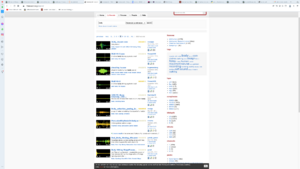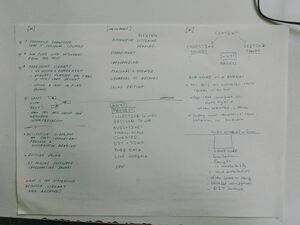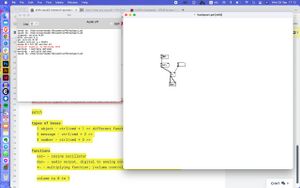Mits'👾's Hackpact: Difference between revisions
| Line 1: | Line 1: | ||
==It is just a toy .. phew | ==It is just a toy .. phew == | ||
Scattered thoughts, desires and gestures that need to be united (a bit) | Scattered thoughts, desires and gestures that need to be united (a bit) | ||
Revision as of 23:37, 10 October 2022
It is just a toy .. phew
Scattered thoughts, desires and gestures that need to be united (a bit)
Parallel experiments, that occupy my soul 🎃
1. Reading and annotating Situated knowledges by Donna Harraway
pad
https://pad.xpub.nl/p/situated_knowledges
experiment with body and embodiment in python
(in the future)
Gathering my annotations
a.statements:
Who has a body?
We don't want to represent the world.
We don't want one body
Universality is reductionism
Prosthesis and not objectivity
All vision has an embodied nature
The body is an agent not a resource
How to see from below?
Vision requires instruments of vision
Who can and who cannot?
How to see?
Where to see from?
What limits to vision?
What to see for?
What other sensory powers do we wish to cultivate besides vision?
Location is about vulnerability
Situated knowledges are about communities and not about individuals
Sex as an object of biological knowledge
Homogenising all the world's body into resource 👎🏼
Nature is only the raw material of culture 👎🏼
Situated knowledges require that the object of knowledge is an actor or agent
Conversation vs discovery
Bodies as objects of knowledge are material-semiotic, generative nodes
b.keywords:
subjugated knowledges
location
embodiment
partial perspective
politics of vision
fantastic imaginings
local knowledges
2. Python script: Re-using the prototype that joseph and manetta made for getting sounds from the freesound.org library. Obtaining all the sounds with the entry point "body" ---> https://freesound.org/search/?q=body&page=8#sound
import freesound
import IPython.display as display
import time
import sys
client = freesound.FreesoundClient()
client.set_token("I9hnJgZKfaxnWEz0YEwPcjjVYLYYuqBDnBBPUv5R","wZupevhDwA6jIfOgzUgn")
def slowly(s):
for l in s + '\n':
sys.stdout.write(l)
sys.stdout.flush()
time.sleep(1./100)
slowly("""
,---------------------------,
| /---------------------\ |
| | Hello, | |
| | I am the famous | |
| | foley artist bot! | |
| | What should I play | |
| | for you. Pls type! | |
| \_____________________/ |
|___________________________|
,---\_____ [] _______/------,
/ /______________\ /|
/___________________________________ / | ___
| | | )
| _ _ _ [-------] | | (
| o o o [-------] | / _)_
|__________________________________ |/ / /
/-------------------------------------/| ( )/
/-/-/-/-/-/-/-/-/-/-/-/-/-/-/-/-/-/-/-/ /
/-/-/-/-/-/-/-/-/-/-/-/-/-/-/-/-/-/-/-/ / 16:06, 27 September 2022 (CEST)16:06, 27 September 2022 (CEST)16:06, 27 September 2022 (CEST)16:06, 27 September 2022 (CEST)16:06, 27 September 2022 (CEST)16:06, 27 September 2022 (CEST)16:06, 27 September 2022 (CEST)Mitsa (talk) 16:06, 27 September 2022 (CEST) """)
search=input()
print("""
,---------------------------,
| /---------------------\ |
| | Great, | |
| | I will play for you: | |
| | """+search[:20]+" "*(20-len(search))+""" | |
| | BTW: Robots of the | |
| | the world unite <3 | |
| \_____________________/ |
|___________________________|
,---\_____ [] _______/------,
/ /______________\ /|
/___________________________________ / | ___
| | | )
| _ _ _ [-------] | | (
| o o o [-------] | / _)_
|__________________________________ |/ / /
/-------------------------------------/| ( )/
/-/-/-/-/-/-/-/-/-/-/-/-/-/-/-/-/-/-/-/ /
/-/-/-/-/-/-/-/-/-/-/-/-/-/-/-/-/-/-/-/ / 16:06, 27 September 2022 (CEST)16:06, 27 September 2022 (CEST)16:06, 27 September 2022 (CEST)16:06, 27 September 2022 (CEST)16:06, 27 September 2022 (CEST)16:06, 27 September 2022 (CEST)16:06, 27 September 2022 (CEST)Mitsa (talk) 16:06, 27 September 2022 (CEST) """)
results = client.text_search(query=search,fields="id,name,previews,url")
print(results)
counter = 0
for sound in results:
counter = counter + 1
if counter == 20:
break
print("I will play for you: "+sound.name)
sound.retrieve_preview("./sounds",sound.name.replace('/','_')+".mp3")
print(sound.url)
time.sleep(1)
display.display(display.Audio("./sounds/"+sound.name.replace('/','_')+".mp3", autoplay=True))
b. experiment of performning the sounds from https://freesound.org/search/?q=body&page=8#sound , by using the web interface with play and loop button
c. new idea, mixing "body" with other concepts, like "machine"(maybe?), "object", "apparatus"
searching more the idea of soundscapes
3. A reflection diagram of past important projects and a diffractive reading through them
1. Occupations in P-P, creating an archive or oral narrations to reconstruct spatial memory. Important matter the use of verbal language. What if it is equally important the non-verbal use of sounds, as body movement, timbre, tempo, silences, tone of voice
4. Editing sound
The different steps for sound editing
1. Define the archive of sound
a. Import recorded sounds I have made the past months, to create an archive. Try to categorise them with different logics b. Try to edit already existing archive of sounds . example freseound.org library
2. Editing methodologies
From prototyping exercise in Special Issue 18
Loop exercise
Make a sound piece of 30 seconds based on loops. What does it mean to repeat something many times? Does the rhythm of the loop vary while looping? Why did you choose to loop this specific sound? Use one or multiple short sound files, which you either record yourself, generate with audio software like Audacity, or find online.
Cutting exercise
Make a sound piece of 10 seconds based on cuts. Where do you make a cut? Why did you choose to cut exactly there? How can the cut become a writing tool? Use one sound file, which you either record yourself, generate with audio software like Audacity, or find online.
Stretching exercise
Make a sound piece of 30 seconds based on stretching. What do you want to stretch exactly? How far can you stretch your material? Use one sound file, which you either record yourself, generate with audio software like Audacity, or find online. Involve at least 3 different ways of stretching in your piece.
Reversing exercise
Make a sound piece of 10 seconds based on reversing. What is the difference between reversing, inverting and (re)turning? Does going in reverse mean going back in time? Use as many sound files as you want, which you either record yourself, generate with audio software like Audacity, or find online.
5. Approaching the diffractive instrument
1. I started making this pad on the special issue 18, trying to approach how to make an instrument that edits sounds diffractively ( i am stil in search of what this could mean)
pad
2. Diffractive djing
6. Meeting points with al nik
a. pad of references
https://pad.xpub.nl/p/al_mits_references
b. diagramm of keypoints (photo)
c. pure data tutorial



